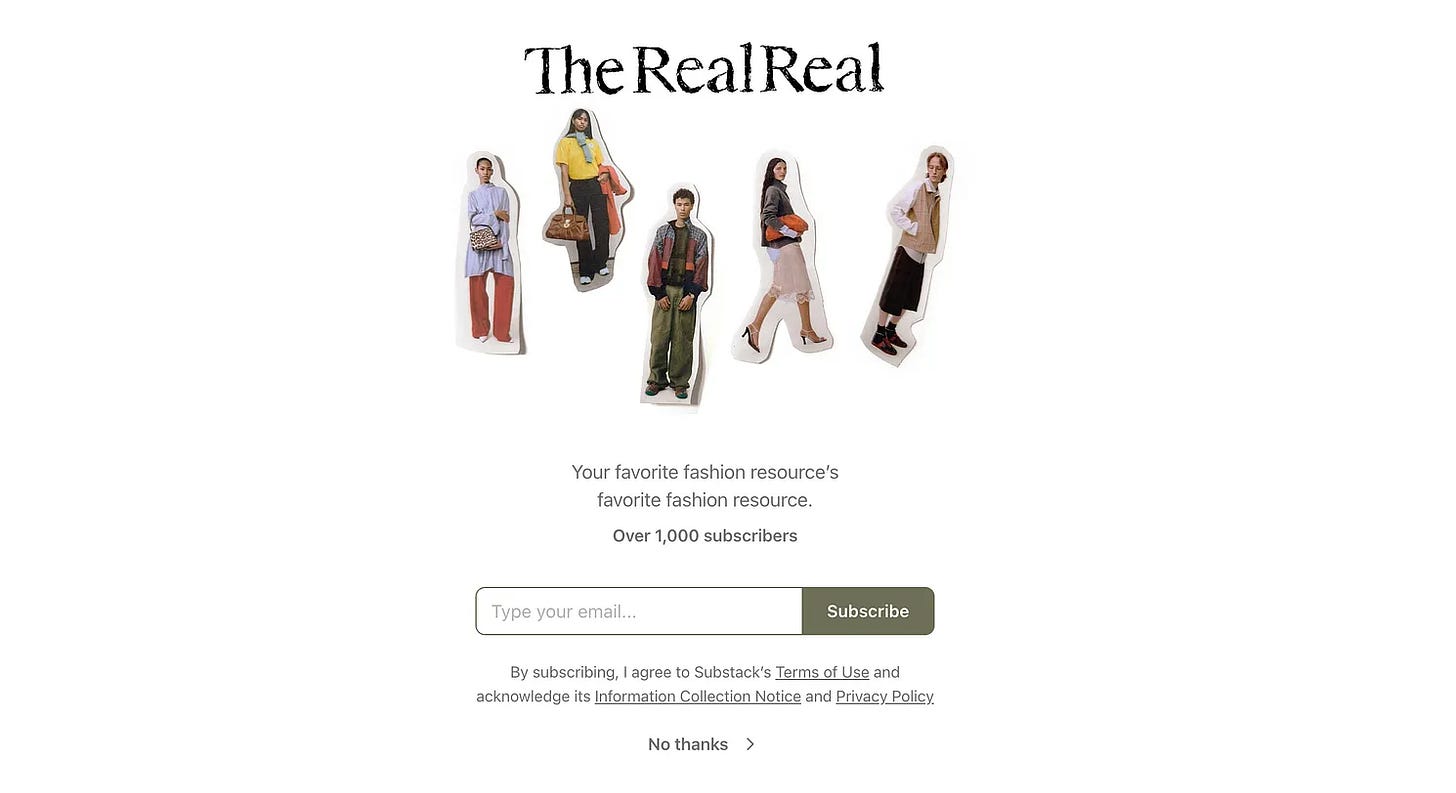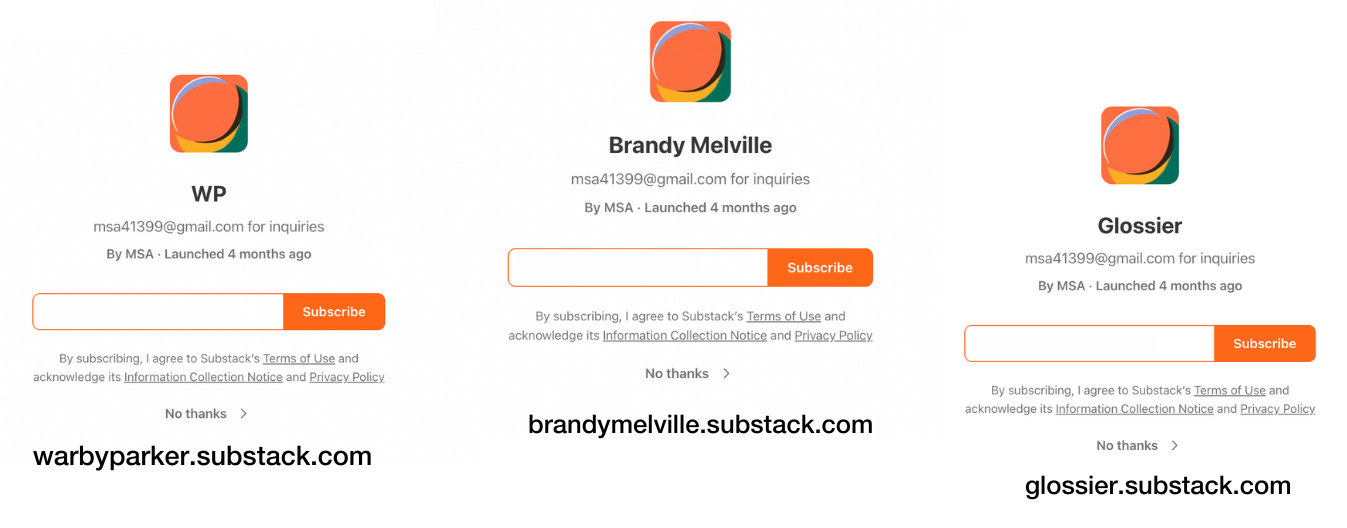Here Come the Brands
Why Tory Burch, The RealReal, Saie, and more are posting on Substack.
This past week I got my first consulting inquiry for Substack. A brand was looking for help starting a presence on the platform. This came right on the heels of The RealReal’s buzzy newsletter launch and Emily Sundberg’s prediction that “We will see more brands trying out Substack this year”.
Brands have mostly participated on Substack in the form of sponsored posts and founder accounts thus far. In part, because the platform’s official “Content Guidelines” state that “Substack is intended for high quality editorial content, not conventional email marketing.” Despite this, a new strategy is being written. Brands are creating Substack accounts and sending out newsletters under their own name.
I spoke with designer Tory Burch, marketing experts, and Substack’s Head of Lifestyle, Writer Partnerships to piece together how brands should approach this new media platform.
Substack vs traditional email marketing
As this wave of brands joining Substack builds, there will be an urge to compare it to traditional email marketing. That would be shortsighted.
Companies can make millions of dollars per month thanks to personalized email flows. A Substack newsletter will never compete with that. That’s because Substack is not an email marketing tool, it’s a community tool. Think of it less as a Klaviyo competitor and more as a TYB competitor.
As an example, I dug into The RealReal’s first newsletter send—a dispatch of what their anonymous writer was searching for after the latest fashion shows. Of the around 21 product links included, 10 of them sold after sending. It’s not nothing, but it’s certainly not replacing a more personalized “Saved Search” update or a notification that items in your “Obsessions” are now on sale.
Still, a Substack newsletter is something a lot of traditional email flows aren’t: fun.
Grace Clarke, marketing consultant and founder of GraceAI, told me, “Clients are asking me more, ‘how fun can we be?’, and less ‘how can we get views’.” I often compare Substack to a lo-fi social post—it’s more approachable simply because it doesn’t feel high effort.
The Substack ecosystem
Importantly, there’s more to Substack than simply a newsletter product. As brands join, they will likely explore subscriber chats, live videos, comment sections, and the Notes social feed.
As a user of Substack myself, I am acutely aware of how the platform feels about big media and big brand. I was curious to see if brands were even technically allowed to post on the platform. I found the below paragraph in their official “Content Guidelines”.
I emailed Christina Loff, Head of Lifestyle, Writer Partnerships at Substack, to learn more about platform’s stance on brands. She told me, “We're laser-focused on helping creators own their relationships with audiences, build their businesses, and make money from direct subscriptions. While we appreciate that brands are starting to see the magic of Substack, we always advise that success comes from bringing a strong, original perspective—not just using the platform as another promotional tool. Brands like The RealReal and Tory Burch have done it well, seamlessly integrating into the existing Substack ecosystem by highlighting and interviewing Substack creators, and embracing what makes this platform special.”
It still seems a bit subjective as to what would constitute “high quality editorial content” versus “conventional email marketing”—The RealReal’s first email send had over 20 product links, remember? I’ll be curious to see how this evolves.
Finally, as with all new marketing platforms, I’d recommend doing your own due diligence on brand safety. Substack has had its fair share of criticism and their founders talk a lot. Have a good understanding of what your brand would be willing to tolerate.
The early adopters
A handful of brands have already started to experiment on Substack, with some joining as early as 2022. I can see why the platform is attractive in this current moment. As social media algorithms prioritize discovery over community, brands are looking for places to have a deeper, more conversational relationship with their audiences. Instagram features like Broadcast Channels and Close Friends aren’t satisfying that need…maybe Substack can?
Blackbird has The Supersonic (over 10,000 subscribers). You can find insider takes for the restaurant professional—features, profiles, essays, lists, interviews, and more.
Tory Burch has What Should I Wear? (over 4,000 subscribers). You can find “products we genuinely love, cultural zeitgeist moments, and the most relevant trends.”
Saie has From the Saie Office (over 3,000 subscribers). It features everything from voter education to staff recommendations to conversations with other brand founders.
Rebel Rebel has Unruly (over 3,000 subscribers). The wine bar sends out recipes, wine videos, and notes about activism.
The RealReal has The RealGirl (over 1,000 subscribers). It’s written in an anonymous first-person voice that’s a mix of DKNY PR girl and Gossip Girl, the newsletter weaves story with links to their site.
Loftie has Little Book of Sleep (not yet launched). It’s described as “notes and musings on sleep.”
I’ve heard more brands are on the way. If you haven’t secured your username, now would be a good time.
Do you have the resources?
Just like any new platform, a brand’s entrance requires a plan. Erika Veurink, consultant and author of Long Live, has also been tapped by several brands for a Substack strategy. She told me, “Starting a Substack as a brand is a great idea if you have the internal talent, the budget to keep it up, and the patience to see an ROI years down the line. But starting a letter is just the beginning. Do you have a plan for engagement? A community manager-type to comment and keep the chat discourse interesting?” Byron Stewart, marketer and author of TAPPED IN, agreed with this sentiment, he told me: “A brand will need to be 100% committed to this workstream. It can't be an afterthought.”
One brand that has been able to make it work is Tory Burch. When I talk to other marketers about brands joining Substack, they often point to What Should I Wear? as a best-in-class example. Tory Burch, designer and founder, told me that they started a Substack as the “next generation iteration” of Tory Daily, the blog they launched in 2009. She went on to say, “Storytelling has always been incredibly important to me, and the way people consume this content has changed. We were drawn to Substack for its authenticity, creativity, and sense of community.”
When I asked Burch what team works on their Substack, she says, “Our creative team runs WSIW, including former fashion magazine editors and art directors. A lot of people in the company love to contribute, whether it’s by pitching ideas or being featured in a shoot outside the office. WSIW is purely editorial and retains the lo-fi spirit of our original blog.”
The resource lift it takes to successfully run a Substack can be a barrier of entry for some brands. I talked to Rose Anderson, Brand Marketing Director at Alex Mill, about why the brand wasn’t on Substack despite partnering with writers on the platform. She said, “I do think we'd have to hire a full-time writer if we wanted to truly show up and grow. It's reminding me of the start of the TikTok era - when all of our bosses were like - ‘can you just do it?’ It isn't so simple!”. For now, the brand shows up via their creative director’s delightful newsletter somstack.
Before you join…
Let’s assume your brand is ready to invest in Substack. Here are things I’d keep in mind for your publication:
Visualize your audience first. Are you trying to reach your super fans? A specific industry?
Most editorial brand extensions fail because they are too self serving. Build something that goes beyond your brand and taps into a universal truth or passion.
Consider building a persona for the writer. Whether they are a real person or an anonymous character, getting your audience invested in the taste and perspective of the author is key.
What role does service play in your newsletter? Can your brand provide deep insights or interesting curation? I could easily see Zillow, Etsy, and eBay using Substack to curate items through an editorial lens.
Be weird! Short, single-topic, kooky newsletters can perform very well.
Ask yourself, would I read this? Then ask yourself again.
It’s still marketing though
Don’t let the casual nature of a Substack confuse you—it’s still marketing. The same rules of organic social media will apply to this channel. I asked marketing lawyer Robert Freund what flags he’d raise from a legal perspective.
“Concerns about using a celebrity's likeness often hinge on whether the content is ‘commercial,’ and that line is easily blurred in the context of something like a Substack post. The most relevant case I'm aware of is Ice Cube (O'Shea Jackson) v. Robinhood, in which Ice Cube sued Robinhood for using his image in a newsletter post. In that case, the court found that Ice Cube didn't sufficiently allege that the use of his image suggested that he endorsed Robinhood's products.”

Freund goes on to say, “A passing reference to a celebrity, or a single unrelated use of a celebrity image in the context of a lengthy blog post might be permissible, but brands should carefully consider the totality of the circumstances. Merely mentioning a show like Severance is probably not going to pose a problem, but again, brands should be careful not to imply any endorsement or affiliation, and the overall context is important. Separate from publicity rights issues, copyright issues are a separate concern. Using an image or a clip from Severance, or using a photo of a celebrity, could give rise to copyright infringement claims from the rights holders.”
What’s next?
You can’t just dip your toe in on Substack. It requires strategy and consistency—something most brands won’t be able to commit to. That’s okay. I do not think every brand needs to be on Substack. It’s very early days for the platform from a brand perspective.
Still, based on the amount of “Should we start a Substack?” conversations I am hearing, I know many marketers are considering joining. If your brand has been noodling on a brilliant editorial idea or looking for a place to let your community connect, Substack is worth consideration—especially if you already know your audience is posting there. Just don’t expect deep analytics, user demographics, or anything a traditional marketing platform would guarantee. Your biggest KPI will likely be “how much fun are we having”. For the right brands, that’s a metric worth investing in.







I’ve seen a lot of criticism of Substack for not making the platform more friendly for brands. On the surface, I’ve agreed with the feedback, but if I more thoughtfully consider Substack’s POV, my position changes. They’re pretty clear on who they’re for (writers) and what they want here (high quality editorial content). If they try to be everything to everyone, and actively recruit more brands to the platform, they’ll quickly dilute the quality of the product. I’m interested to see what happens but ultimately, I’m supportive of their current priorities.
Longtime fashion/beauty brand marketer here. Substack presents an interesting 'white space' opportunity in the eyes of brands as it's a growing nexus of influence, and reaches high-value audiences with high purchase intent. But the unfortunate reality is that precious few are resourced in a way that would allow them to nurture meaningful community on platform. (It will be interesting to see who tries!)